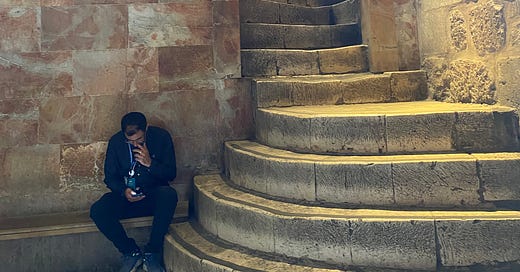grace
As I was leaving Jerusalem, and going on the final errands of gathering the necessary gifts and souvenirs for those back home, James asked me to get some small wooden crosses as gifts and touch them to various holy sites for friends and family.
And so I found myself doing that very thing that I saw so many cheesy Eastern European female tourists of a certain age doing: bringing a bag load of religious tchotchkes that I purchased for a sum equal to highway robbery and dumping them all over marble that was probably younger than the U.S. Capitol building.
This is sort of silly, I thought. It seems embarrassing and a bit superstitious. What power do these stones have? And why does it matter that these crosses touch them rather than just being waved in their general direction? Is that really what our faith is? Bits of stone and wood combining to amplify prayer power? Sounds like what druids in the Irish forests practiced.
What does proximity actually mean to faith? Does closeness really matter, when God is, our catechism tells us, everywhere?
I don’t know.
I really don’t know.
But on Saturday morning, I walked up the stairs (pictured above) to the chapel of Calvary. Usually, they are impassable, as they are stuffed full of pilgrimage groups walking the final stations of the Via Dolorosa, and Calvary is a madhouse. This morning, it was quiet. A Polish priest was saying Mass in English right as I arrived. After our Mass of four (the priest, two nuns, and myself), I brought the crosses over the rock underneath the Greek Orthodox altar of Calvary (the chapel is, of course, split in two, because no one in our church can agree or cooperate on anything). The Greek Orthodox altar covers the stone of the original rock quarry that has been here since before Christ was born. The rock quarry that, they say, builders dug out in a particular way around the flaws so that the hill ended up looking like a skull.
I spread the crosses out over the rock, and as I prayed over them with the unthinkingness of ritual, prayed for the graces of this place to be present in them, something in my heart paused in the middle of that rote action to pose a question:
Do you really believe there is grace here?
Do I really believe that it matters that the ground under my feet was where salvation took place? Where a man was crucified in a terrible, bloody death? Who would watch such a demise or linger in such a bleak place?
This is less a question about belief in archeology or the question of historical fact. In terms of historicity, Calvary passes most tests: outside the Roman-era walls, a quarry shaped like a skull, a temple to Venus built there to discourage Christian veneration. It’s also covered up with millennia of accoutrements of veneration. This place is a scrapbook of Christian history, a patchwork quilt of pilgrims’ shared heritage.
It’s less a question of fact and more, in this moment, a question of faith.
Do I really understand that this rock I’m looking at is the place where a man died—and yet he lives? Something happened here of such significance, it’s a miracle the earth does not break under its weight.
Everything in the holy land is covered up in all the things we think are precious—gold, iconography, marble, paint, tile, mosaics—the things we think are ways to mark the holy. It’s hard to come face-to-face with the place itself. The land that holds all these memories itself.
But there it is, the land, right underneath my feet, I can see it with my eyes, touch it with my fingertips, encased in glass. Here, here, right where I am, is the place. The place we tell stories about and commemorate and do this all in the memory of. I grasp the hem of the mystery, but it’s so much larger than my comprehension, it shimmers just outside of reach.
There is grace here. And I feel it pulsing through the prayers of the Chinese students praying silently around the chapel, through the quiet over Calvary, and through the place itself, visible underneath all the ornaments we’ve heaped upon it.
I gather up my small crosses, back into their paper bag.
I go down the mountain. Down the second staircase, built where the Crusader Kings’ tombs once laid.
I leave changed. Not sure exactly how, but that change is interwoven with the prayers over those crosses and in the mysterious grace I can’t name that’s somehow here. And I think we carry it away with us in small ways, in trinkets of wood, but perhaps, more importantly, in our hearts more softened to mystery.





